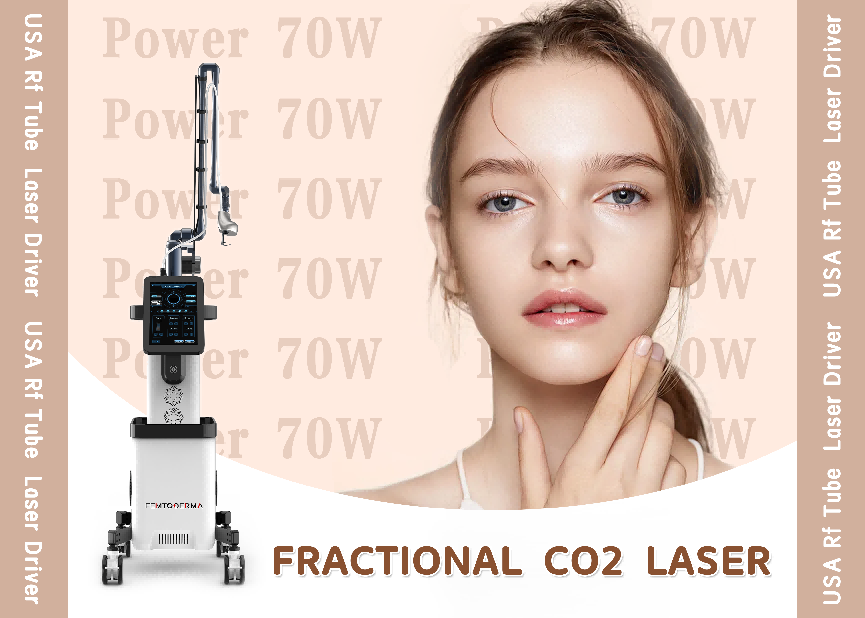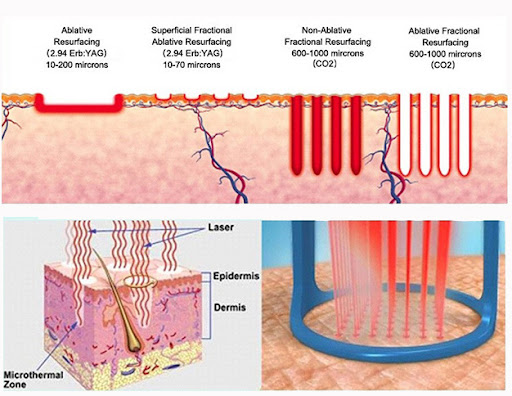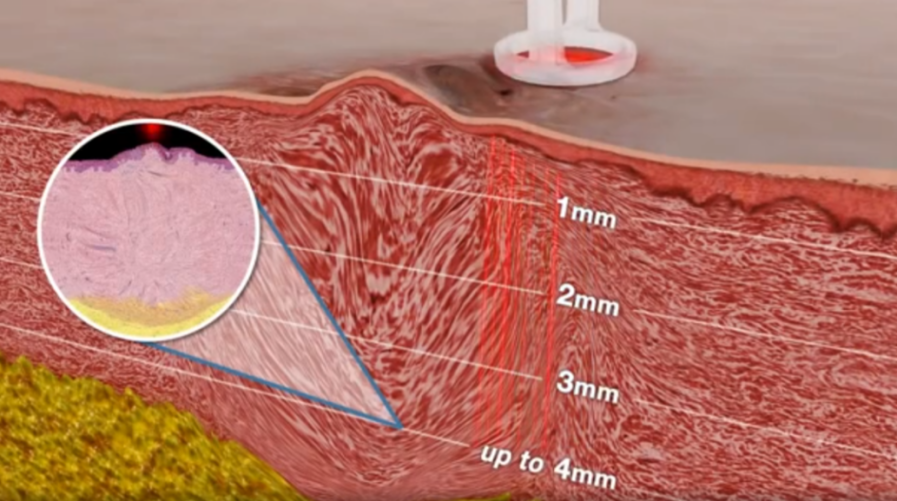CO2 Laser Resurfacing: How Many Sessions? Results & Recovery Explained

1. What is Fractional CO2 Laser
Fractional CO2 Laser is a revolutionary technology in the field of skin repair, which improves various skin problems through the principle of selective photothermal effect. Unlike traditional lasers, it uses a pixelated microbeam mode to create countless minimal treatment zones (MTZs) only on the skin, while preserving healthy tissue around it, significantly reducing the recovery period and improving safety.
Fractional CO2 laser, as a representative, uses a laser beam with a wavelength of 10600nm to precisely target the skin, particularly adept at treating concave scars (such as acne scars), deep wrinkles, and photoaging issues. Its advantage lies in its ability to achieve both exfoliative effects (removing damaged epidermis) and promote dermal collagen remodeling through thermal stimulation, achieving the therapeutic goal of “breaking then rebuilding”.
2. Working Principle of Fractional CO2 Laser
The core mechanism of fractional CO2 Laser includes triple effects:
Minimally invasive stimulation: Laser beam penetrates the epidermis to form a micro thermal injury zone with a diameter of about 0.1mm, reaching a depth of up to the middle to deep layers of the dermis. These micro wounds only cover 15% -20% of the skin area, retaining healthy tissue as a “biological dressing” to accelerate the healing process.
Collagen rejuvenation: Heat injury activates fibroblasts, stimulating the regeneration of type I and III collagen. Clinical studies have shown that a single treatment can increase dermal collagen density by 30% -40%, and this process lasts for 3-6 months.
Epidermal renewal: Damaged areas of pigmentation or abnormal keratin are precisely cleared, and new epidermal cells migrate from surrounding healthy tissues to cover the wound, achieving uniform skin color.
It is worth noting that the fractional treatment makes it both safe and effective – it avoids the large-scale trauma of traditional grinding lasers and achieves deep skin reconstruction through cumulative effects.

3. Treatment Framework: Understanding the Basic Treatment Cycle of Fractional CO2 Laser
The therapeutic effect fractional CO2 Laser has progressive accumulation and needs to follow scientific treatment intervals. The basic course of treatment usually consists of 3-5 sessions, with an interval of 4-6 weeks between each session. This design is based on the physiological repair cycle of the skin:
- Initial repair stage (0-7 days): Micro injury triggers a peak in the expression of heat shock protein (Hsp47), initiating an inflammatory repair response.
- Collagen proliferation period (2-8 weeks): Fibroblasts actively synthesize new collagen, and scar tissue gradually softens.
- Mature stable period (3-6 months): Collagen fibers rearrange and skin texture continues to improve.
Clinical data shows that 93.1% of patients achieve significant improvement after completing the full course of treatment. Shallow problems (such as fine lines) may take effect 2-3 times, while deep ice cone scars often require 4-5 treatments. Premature repeated treatment can interfere with collagen formation, while excessively long intervals may prolong the overall course of treatment.
4. Analysis of Key Variables Affecting the Frequency of Treatment Courses
4.1 Skin condition
Deep scars (such as ice-pick scarring and boxcar scarring) require multiple treatments and gradual filling due to the involvement of the dermal mesh layer and even subcutaneous tissue. In contrast, superficial enlarged pores or fine lines react faster. The degree of photoaging also affects the course design – severe photodamage to the skin often accompanies dermal atrophy, requiring 4-5 intensive stimulations to rebuild the collagen network.
4.2 Treatment Objectives
Patients who pursue natural and gradual improvement may choose low-energy multiple treatments, while those who hope for quick results may accept high-energy regimens (extended recovery period). It is worth noting that although a single high-energy therapy may seem effective, it may increase the risk of pigmentation, especially in Asian populations.
4.3 Skin Types
Fitzpatrick III-IV skin requires more conservative parameter settings and interval periods (usually extended to 3-4 months) to avoid post inflammatory pigmentation. On the contrary, Type I-II skin can tolerate higher energy densities, and the treatment course may be shortened by 1-2 times.
4.4 Recovery time
Patients who can arrange sufficient recovery periods can choose more effective treatments to reduce the total number of occurrences. Clinical observations have found that the collagen regeneration quality in the treatment group with an interval of more than 6 weeks is better than that in the intensive treatment group.
5. Horizontal Comparison: Differences in Treatment Courses Between CO2 Laser and Other Technologies
5.1 Internal comparison of ablative lasers
Erbium laser (2940nm) has a water absorption rate 10 times higher than CO2 laser, making it more suitable for superficial problems, but requires more courses for deep scars. Research has shown that the improvement rate of scars in boxcar scarring by CO2 laser (93.1%) is significantly higher than that by erbium laser (84.6%), but the incidence of pigmentation is also higher (89.3% vs 42.9%).

5.2 Comparison with non-ablative laser
Non-ablative lasers (such as 1550nm) have almost no recovery period, but require more than 5 treatments to achieve the effect of CO2 laser 3 times. Its improvement rate for deep scars is only 25% -40%, which is suitable for patients with mild problems who cannot accept the recovery period.
5.3 Fractional RF Technology
Transmitting rf energy through insulated microneedles to avoid skin damage, especially suitable for high-risk individuals with pigmentation. The treatment design is similar to that of CO2 laser (4-5 times), but 71.4% of patients still believe that the effect of CO2 laser is more significant, despite its longer recovery period.
6. Postoperative Care and Complication Prevention System
6.1 Stage care standards
For 48 hours of gold time, the wound should be kept dry strictly, and spray containing copper peptide should be used to promote healing. Avoid physical friction before scab shedding, and apply SPF50+sunscreen daily for new skin. The prevention of pigmentation should continue until the next treatment. It is recommended to combine tranexamic acid essence.
6.2 Selection of key skincare products
During the wound stage, priority should be given to choosing equipment type dressings, such as collagen patches. The scar gel containing silicone combined with vitamin C derivatives is used in the newborn skin stage. Long term maintenance can introduce low concentrations of retinol (0.2% -0.5%), but it should be discontinued 2 weeks before the next treatment.
Q&A
Q: How long can the effect last?
A: The complete course of treatment usually lasts for 1-3 years, and maintenance treatment 1-2 times a year can prolong the effect. Strict sun protection and retinol use are key.
Q: Is it treating pain?
A: Preoperative surface anesthesia (compound lidocaine cream) can reduce the pain score to 4.2/10 points, and the intraoperative cold air system can further alleviate discomfort.
Q: Can other treatments be combined?
A: Recommended staging combination: First, subcutaneous dissection to relieve scars, followed by CO2 laser treatment 2 months later, and then injection of fillers every 2 months.
Q: What if the treatment is ineffective?
A: Factors such as insufficient energy settings, severe scar fibrosis, or postoperative infections need to be investigated. Stubborn scars can be treated with targeted therapy using high-energy single point focusing technology (80-100mJ).





